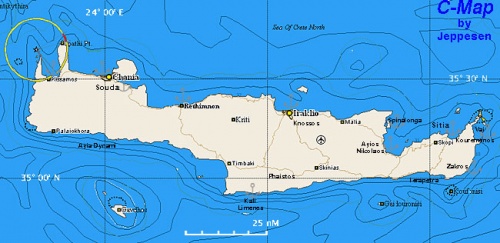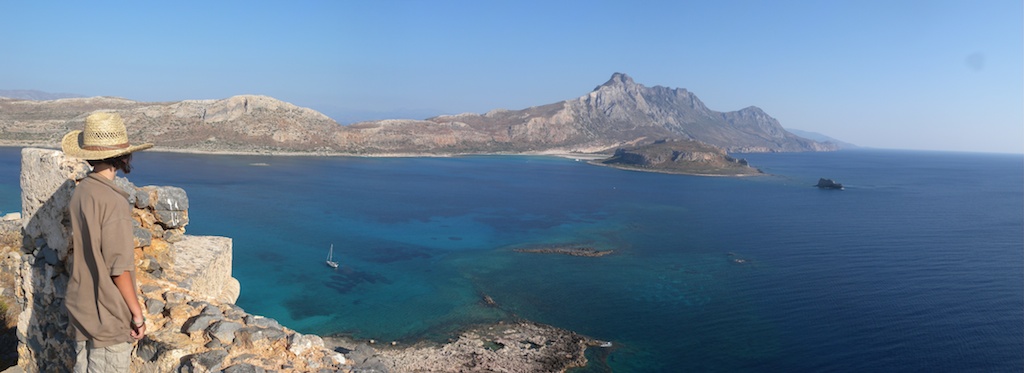Crete
From CruisersWiki
Crete
| | |
| | 35°21′N, 25°09.2′E |
|---|---|
| | Photo gallery |
| | Local chartlet |
Crete (Κρήτη) is the largest island of Greece and the fifth largest island in the Mediterranean. It has an area of about 8,300 km2. A mountainous island, it lies south of the Aegean Sea, a link between Europe, Africa and Asia. This geographical position, being at the junction of major civilizations and cultural currents, has influenced its history throughout the past 6,000 years The island has an elongated shape, 260 km long from east to west and between 15 and 60 km wide. The coastline is over 1,000 km long and consists of both sandy beaches and rocky shores. The high mountains are a characteristic of the Cretan landscape. They form three mountain complexes, each with its own 'personality'. Between the ranges lie semi-mountainous zones which cover the greater part of the island. There are also a few low lying plains as well as a number of high plateaux. Crete has about 600,000 inhabitants, of which over a third live in the towns of Iráklion, Chania and Rethymnon. The rest of the island is sparsely populated, with large tracts of mountainous areas frequented only by shepherds
Crete had one of the world's earliest civilizations, the Minoan Civilization, named after King Minos, the legendary author of Cretan institutions; in the ruined palace at Knossos invaluable finds have been made. The Cretan kingdom reached its greatest power, prosperity, and civilization circa 1,600 BC. Later, for reasons still obscure, its power suddenly collapsed; but Crete flourished again after the Dorian Greeks settled on the island in large numbers and established city-states. Among the most powerful of the cities (110 in number, according to Homer) were Knossos and Cydonia (modern Khaniá - Χανιά). Although important as a trade center, Crete played no significant part in the political history of ancient Greece. It became a pirate haven in the 3d century BC but was conquered (68 - 67 BC) by the Romans under Quintus Metellus.
Crete passed (395 AD) to the Byzantines, fell (824) to the Arabs, but was reconquered by Nicephorus Phocas (later emperor Nikephoros II) in 961. As a result of the Fourth Crusade, the island passed to Venice in 1204; and in 1212, after expelling rival Genoese colonists, the Venetians set up a new administration, headed by a duke. Under Venetian rule Crete was generally known as Candia (the Venician name for Iráklion) because that was the place of the duke's residence. During Venice's rule, —more than four centuries long— Renaissance swept through the island as is evident from the plethora of artistic works dating to that period. The most notable figures of this Cretan renaissance are the painter Dominicos Theotokopoulos (El Greco) and the poet Vitsentzos Kornaros. Kornaros' romantic epic Erotokritos (Ερωτόκριτος) is still sung in Crete today. Insurrections against the arbitrary Venetians were frequent, and the Cretans were not displeased when they changed masters after the Ottoman Turks conquered (1669) virtually the whole island following a 24-year war. Two offshore island fortresses remained in Venetian hands until 1715.
The Cretans revolted with some regularity against the Ottomans and were very active participants in the Greek War of Independence of 1821. But after the war, Crete did not become part of the newly formed Greek state. After a series of revolts against the Ottomans in the 19th century a climax was reached in the insurrection of 1896-97 that led to war between Greece and Turkey (1897). This war was disaster for Greece. But the European powers intervened in the war, forcing Turkey to evacuate (1898) Crete. An autonomous Cretan State was formed under nominal Turkish rule, but it was governed by a high commission of the occupying powers (England, France, Russia, and Italy). The Cretan national assembly, led by Eleutherios Venizelos, declared in favor of union with Greece, but the powers rejected its demand. The Young Turk revolution of 1908 in Turkey, however, enabled the Cretans to proclaim their union with Greece, and in 1909 the foreign occupation troops were withdrawn.
Cretan representatives were admitted to the Greek parliament in 1912, and in 1913, as a result of the Balkan Wars, Crete was officially incorporated into Greece on 1 December 1913 and eventually Venizelos became the prime minister. After Venizelos lost the 1932 elections his followers, who controlled Crete, led an uprising (1935) against the imminent restoration of the monarchy but were defeated by General George Kondylis. A new revolt (1938) against the fascist dictatorship of John Metaxas was also suppressed.
In World War II, Crete was used as a British military and naval base late in 1940. The British and Greek forces on the Greek mainland evacuated to Crete in 1941, but they were quickly overwhelmed by the Germans in a large-scale airborne invasion, the first of its kind known as the Battle of Crete. Late in 1944, British ships isolated the German occupation troops, who eventually surrendered. In the postwar period there was some Communist guerrilla activity on the island.
Crete has made great contribution to Modern Greek culture. Notable Cretans are: Nikos Kazantzakis (1885-1957) influential philosopher, poet and author; Odysseas Elitis (1911-1996) Nobel laureate poet; Nana Mouskouri (1934) popular musician and singer; and many others.
Charts
- BA
- 1685 Nisís Venetico to Nísos Spétsai including the channels between Akra Malléas and Kríti
- 1091 Nisos Kriti
- 3678 Kríti- north coast. Rethymnon to Kólpos Merambéllou
- 3679 Nísos Kríti to Nísos Kárpathos
- 3680 Kríti - southern coast: O Loutró to Ierápetra
- 3681 Kríti - Western part
- Imray-Tetra
- G3 Aegean Sea (South)
- G37 Nísos Kriti (West)
- G38 Nísos Kríti (East)
- NIMA
- 54300 Nisis Proti to Nisos Spetsai incl. N.W. Coast of Kriti
- 54320 Kiklades Nisoi to Kriti
- 54322 Kriti
- Greek
- 432 Kriti I. - West Part
- 433 Kriti I. - West Central Part
- 443 Kriti I. - East Central Part
- 444 Kriti I. - East Part
Radio Nets
Also see Cruiser's Nets
- Coast Guard - VHF channel 12, Tel. +30 28210 24 4956 (Central for all Crete)
- Olympia Radio - VHF channels 83 & 84 (Knosos), 26 & 27 (Sitia), 85 & 86 (Phaistos)
Weather
See Aegean Sea.
Approaches to northern Crete are straightforward but with a strong meltemi there can be a very confused swell. With winds from the north, acceleration will be experienced along both the western and eastern sides of the island, with wind strengths often one or two Beaufort higher than the forecast winds.
If passing along the southern side of Crete, note that there is a west-setting current that will often reach up to 1.5 knots off some of the headlands. On the northern side, there is a similar current that occasionally reaches up to 0.5 knots.
Caution: Be aware that along the southern coast of Crete there can be ferocious gusts when the wind is either from the north or the west. These gusts seem to set in whenever the forecast for the northern side of the island exceeds force 6 and it is wise to reef down in these conditions before leaving harbour. It is a sensible precaution if traversing this coast to get at least a five-day weather forecast and to take note of the berthing arrangements in the only safe havens along the coast in a meltemi, namely Palaiochora, Agia Galini, Loutro and Ierapetra.
Check-in facilities
There are many harbors in Crete but very few natural anchorages.
Ports and Popular Stops
Ports
- Kissamos (Needs data)
- Chania (Port of Entry)
- Souda
- Iraklio (Port of Entry)
- Rethimno
- Khersonissos (Needs data)
- Palaiochora
- Loutro
- Agia Galini
- Sitia
- Kali Limenes (Needs data)
- Ierapetra
Anchorages
- Spinaloga
- Kouremenos
- Chora Sfakion
- Ayia Roumeli (Needs data)
- Ormos Zakros
- Vai
- Gramvousa - West End of Isld.
Marinas & Yacht Clubs
- Ayios Nikolaos (Port of Entry)
Yacht Services and Repairs
See each Port
Marine Stores
See each Port
Yacht Services/Repairs/Yards
See each Port
Fuel, Water, & Electricity
See each Port
Offshore Islands
Tourism & things to do ashore
See each Port/Stop
Routes/Passages To/From
Cruiser's Friends
Contact details of "Cruiser's Friends" that can be contacted for local information or assistance.
Forum Discussions
List links to discussion threads on partnering forums. (see link for requirements)
External Links
- Crete (Wikipedia)
- Minoan Civilization
References & Publications
See Greece.
Last Visited & Details Checked (and updated here)
See the pager of an individual port.
Personal Notes
Personal experiences?
|
|---|
|
Names: Lighthouse, Istioploos, Athene of Lymington |
| |
|---|
| | HOMEPAGE | Wiki Contents | Mediterranean | Aegean Sea | Greece | Crete | |


